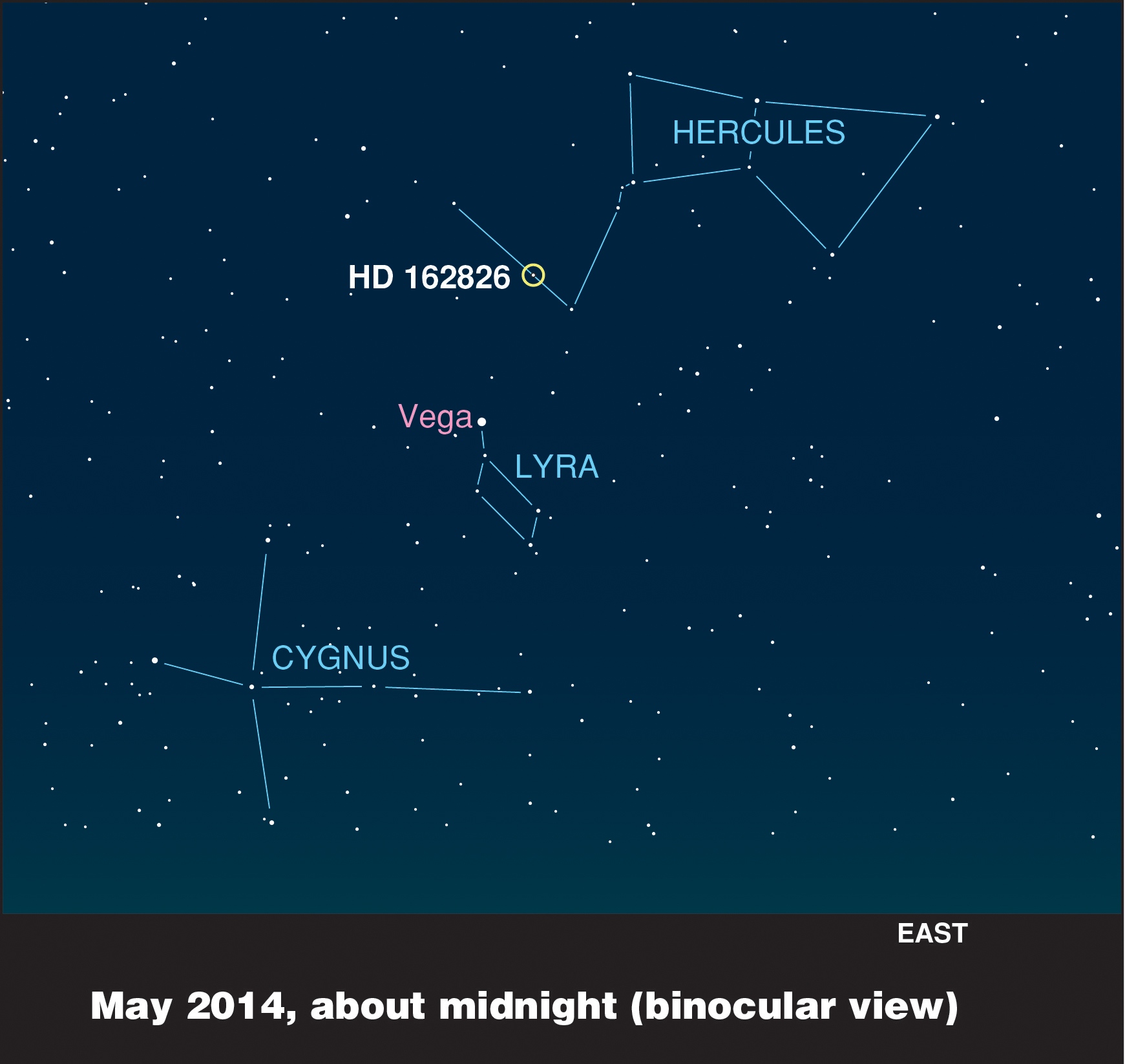Astronomers find Sun’s sibling star
May 12, 2014

Solar sibling HD 162826 can be seen with low-power binoculars near the bright star Vega in the night sky (credit: Ivan Ramirez/Tim Jones/McDonald Observatory)
A team of researchers led by astronomer Ivan Ramirez of The University of Texas at Austin has identified the first “sibling” of the sun — a star almost certainly born from the same cloud of gas and dust as our star.
Ramirez’s methods will help astronomers find other solar siblings, which could lead to an understanding of how and where our sun formed, and how our solar system became hospitable for life. The work appears in the June 1 issue of The Astrophysical Journal.
There is a chance, “small, but not zero,” Ramirez said, that these solar sibling stars could host planets that harbor life. In their earliest days within their birth cluster, he explains, collisions could have knocked chunks off of planets, and these fragments could have traveled between solar systems, and perhaps even may have been responsible for bringing primitive life to Earth. “
So it could be argued that solar siblings are key candidates in the search for extraterrestrial life,” Ramirez said.
The solar sibling his team identified is called HD 162826, a star 15 percent more massive than the sun, located 110 light-years away in the constellation Hercules. The star is not visible to the unaided eye but can be seen with low-power binoculars, not far from the bright star Vega.
How to find a solar sibling
The team identified HD 162826 as our sun’s sibling by following up on 30 possible candidates found by several groups around the world looking for solar siblings. Ramirez’s team studied 23 of these stars in depth with the Harlan J. Smith Telescope at McDonald Observatory, and the remaining stars (visible only from the southern hemisphere) with the Clay Magellan Telescope at Las Campanas Observatory in Chile. All of these observations used high-resolution spectroscopy to get a deep understanding of the stars’ chemical make-up.
But several factors are needed to really pin down a solar sibling, Ramirez said. In addition to chemical analysis, his team also included information about the stars’ orbits — where they had been and where they are going in their paths around the center of the Milky Way galaxy. Considering both chemistry and orbits narrowed the field of candidates down to one: HD 162826.
No one knows whether this star hosts any life-bearing planets. But by “lucky coincidence,” Ramirez said, the McDonald Observatory Planet Search team has been observing HD 162826 for more than 15 years. Studies by The University of Texas’ Michael Endl and William Cochran, together with calculations by Rob Wittenmyer of the University of New South Wales, have ruled out any massive planets orbiting close to the star (so-called hot Jupiters), and indicate that it’s unlikely that a Jupiter analog orbits the star. The studies do not rule out the presence of smaller terrestrial planets.
Creating a road map to identify siblings
The finding of a single solar sibling is intriguing, but Ramirez points out the project has a larger purpose: to create a road map for how to identify solar siblings, in preparation for the flood of data expected soon from surveys such as Gaia, the European Space Agency mission to create the largest and most precise 3-D map of the Milky Way.
The data coming soon from Gaia is “not going to be limited to the solar neighborhood,” Ramirez said, noting that Gaia will provide accurate distances and proper motions for a billion stars, allowing astronomers to search for solar siblings all the way to the center of our galaxy. “The number of stars that we can study will increase by a factor of 10,000,” Ramirez said.
He says his team’s road map will speed up the process of winnowing down the field of potential solar siblings.
“Don’t invest a lot of time in analyzing every detail in every star,” he said. “You can concentrate on certain key chemical elements that are going to be very useful.” These elements are ones that vary greatly among stars, which otherwise have very similar chemical compositions. These highly variable chemical elements are largely dependent on where in the galaxy the star formed. Ramirez’s team has identified the elements barium and yttrium as particularly useful.
Once many more solar siblings have been identified, astronomers will be one step closer to knowing where and how the sun formed. To reach that goal, the dynamics specialists will make models that run the orbits of all known solar siblings backward in time to find where they intersect their birthplace.
Abstract of arXiv paper
Dynamical information along with survey data on metallicity and in some cases age have been used recently by some authors to search for candidates of stars that were born in the cluster where the Sun formed. We have acquired high resolution, high signal-to-noise ratio spectra for 30 of these objects to determine, using detailed elemental abundance analysis, if they could be true solar siblings. Only two of the candidates are found to have solar chemical composition. Updated modeling of the stars’ past orbits in a realistic Galactic potential reveals that one of them, HD162826, satisfies both chemical and dynamical conditions for being a sibling of the Sun. Measurements of rare-element abundances for this star further confirm its solar composition, with the only possible exception of Sm. Analysis of long-term high-precision radial velocity data rules out the presence of hot Jupiters and confirms that this star is not in a binary system. We find that chemical tagging does not necessarily benefit from studying as many elements as possible, but instead from identifying and carefully measuring the abundances of those elements which show large star-to-star scatter at a given metallicity. Future searches employing data products from ongoing massive astrometric and spectroscopic surveys can be optimized by acknowledging this fact.